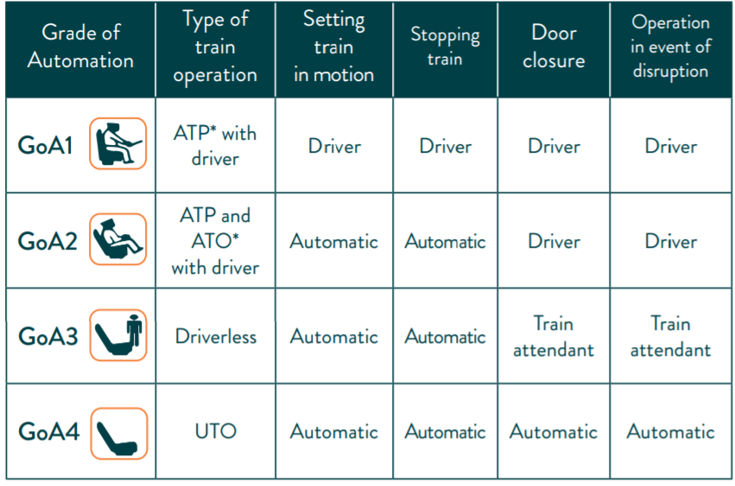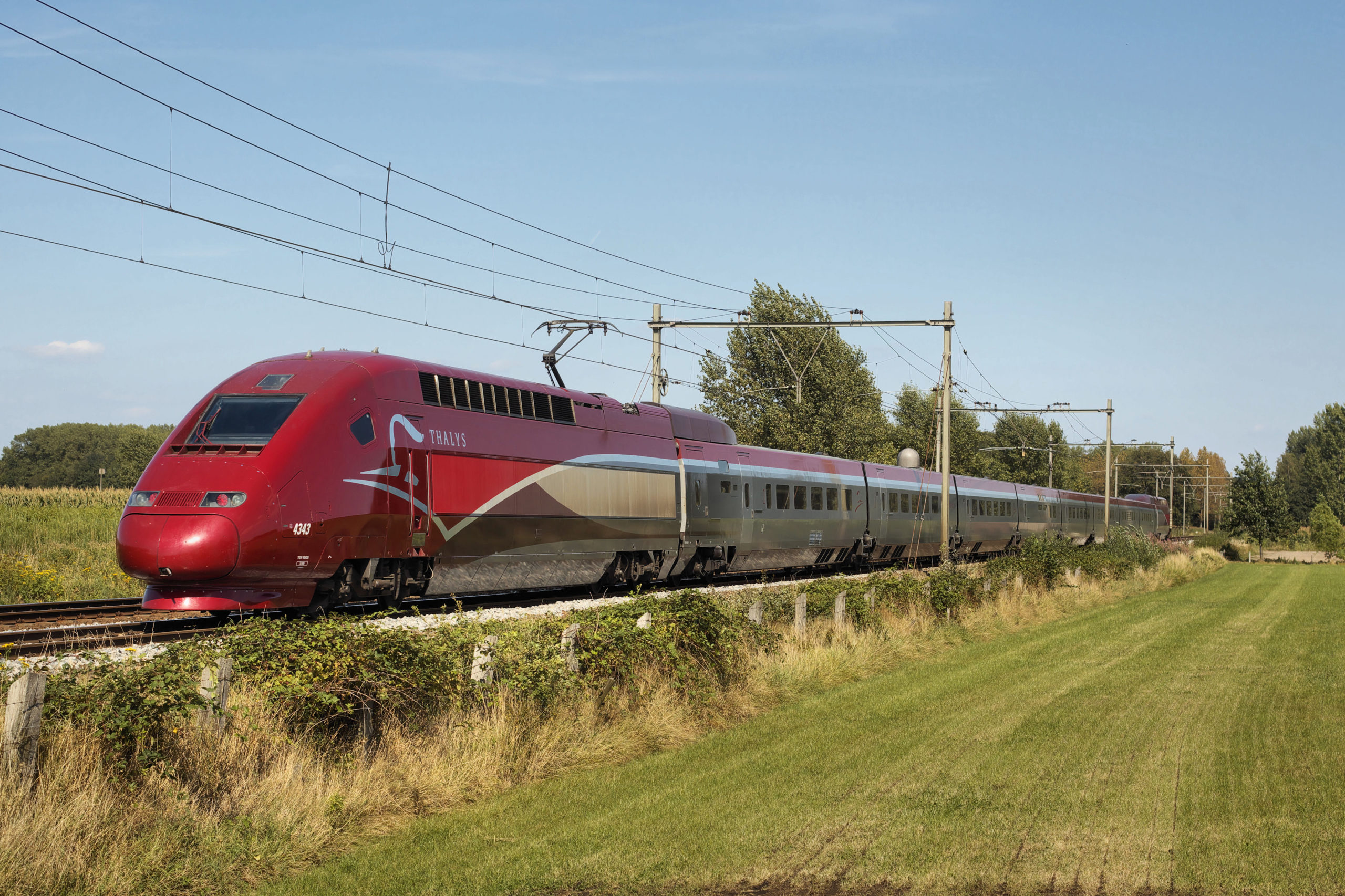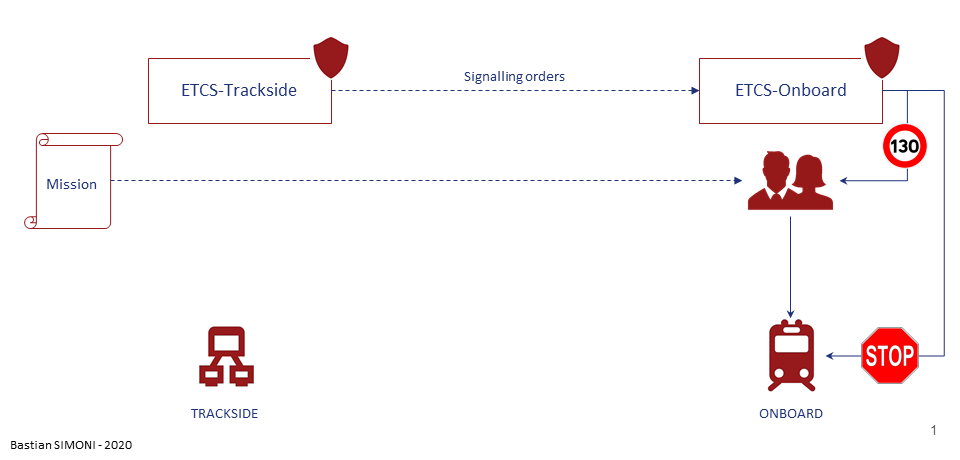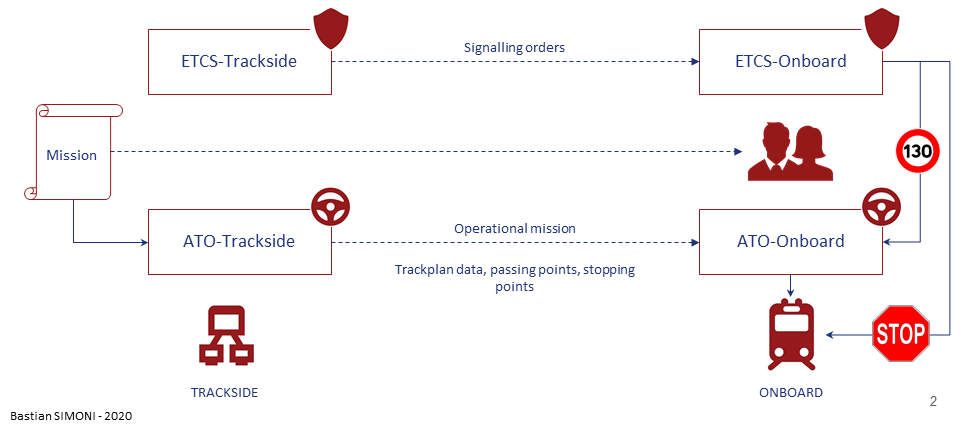An autonomous train, is a train on which traction and braking are performed by an autopilot, respecting the signalling orders and the timetable. Automatic driving can be done in presence of a driver, or unattended.
While unattended train operation is existing for more than 30 years in the Urban context, how is it in the Mainlines ?
How is an autonomous train different from a driverless or unattended metro ? What are the different grades of automation in the railways ? Will we see some day fully autonomous freight or high-speed trains ? The answers in this article !
What is an autonomous train ? by Bastian Simoni is licensed under CC BY-NC-SA 4.0
Introduction
Automation of Metro systems is not something new: technologies for Urban application have been deployed since the 60s. While the milestone of 1000 km of automated metro lines has been reached in March 2018[1], automated operation for Mainline trains is nearly non-existent.
In 2021, some trains in Czech Republic provide automated driving with a national system [2], and China is experiencing automated driving up to 250 km/h on some units [3].
Mainline Automatic Train Operation is now under the spotlights, with one operational system operated by Rio Tinto [4], several pilot projects in Europe [5][6], and a standardization project sponsored by the European Union[7].
In this article, I will drive you into the world of Mainline ATO, its concepts and key challenges.
What is ATO?
ATO stands for Automatic Train Operation, consisting in a set of systems aiming to bring automation into the operations of trains.
ATO is coupled with Automatic Train Protection (ATP), that ensures the supervision of the train: the overspeed and trespassing of danger points detection. ATP activates the emergency brake when these events occur.
The International Association of Public Transport (UITP) has defined four levels of automation, named Grades of Automation (GoA), from GoA1 up to GoA4 [8].
GoA1 is the first Grade of Automation, in which the driver is responsible for all actions, with ATP supervision.
In GoA2, traction and braking are performed automatically by ATO, supervised by ATP. The driver is still present to supervise the doors operation, and operations when disruptions occur.
In GoA3, there is no driver anymore, but onboard staff remains present. GoA3 is also called Driverless Train Operation (DTO).
In GoA4, there is no more staff within the vehicle, all operations being automated. GoA4 is also called Unattended Train Operation (UTO).

Figure 1 : Grades of Automation according to UITP
ATO for Urban application has already a quite important history, first metros being equipped with ATO in the late 60s.
First technologies were pure analogue, like the Pilotage Automatique, used on 90% of the Parisian network in 1979 by operator RATP [9].
Analogue systems were replaced with digital solutions in the 90s. Current technology is based on CBTC [10] (Communication Based Train Control), which can provide both ATP and ATO functions.
Why ATO?
Rising urbanization and passenger increase in public transportation leaves two choices to operators to face this issue:
– Build new tram/metro/suburban lines
– Bring existing lines to full capacity
The first choice can be very difficult, costly, and time-consuming, when new tunnels must be made. The second option, which can be named “Signalling instead of concrete” uses the latest digital technologies, to enable one train every 90 seconds at peak hour.
Some cities have already made the choice to use state-of-art signalling systems coupled with ATO, to operate a metro system with maximum capacity.
On Mainline, the increase of capacity is also a critical topic. Some portions of the railway network can be heavily used by passenger and freight trains, sometimes at full capacity. By combining a digital signalling solution, and homogenous driving of the train with ATO, the capacities can be increased.
One example is the LGV+ project in France, consisting in a re-signalling of the LGV Paris-Lyon, and adding ATO, to extend the capacity to 16-18 TGV/hour (today 13 TGV/hour)[12]. This re-signalling project has made the alternative LGV Paris/Clermont-Ferrand/Lyon obsolete.
Considering the 2t CO2eq/year that each one of us will have to reach in 2050 to respect the Paris Climate Agreement, air travel will have to be limited. Experts recommend forbidding air travel when a train connection lower than 4:30 exists [13], and France has already banned flights when a train connection lower than 2:30 exists [14].
This modal shift may create tensions on the railway network, and capacity increases with digital signalling and ATO can be a good candidate for it.
ATO for mainline trains
For Mainline application, interoperability is a high concern to facilitate border crossing and railway network access to multiple operators. It is also meant to enhance innovation and competitiveness by granting interchangeability of components.
ATO is more recent for Mainline application compared to Urban, as Urban can be built as a homogenous and unified system, where Mainline has a long history, with heterogenous systems.
Moreover, between 1970 and 2000, national ATP systems (also named Class B systems [15]) have been deployed, to enhance the safety of railway. These systems were supplier specific and not all designed to provide an ATO function.
Some examples of ATO over Class B can be highlighted:
– In Czech Republic, with ATO GoA2 deployed in 1992 [16].
– In Germany, with Automatische Fahr- und Bremssteuerung (AFB), a Cruise Control functionality [17], deployed on lines equipped with LZB national ATP.
Since the 2010s, the idea to develop an interoperable Mainline ATO has emerged, in the continuity of the development of a unified European signalling system.
ATO over ETCS : the core system of the autonomous train
The numerous national ATP deployed during 1970-1980 lead to serious difficulties to cross borders easily. For example, the Thalys TGV PBKA units able to run in France, Germany, Belgium, and the Netherlands, are equipped with 7 ATP systems.

Figure 3 : A TGV PBKA unit – Par Mauritsvink — Travail personnel, CC BY 3.0
In the late 80s, a first initiative to build a unified Mainline signalling system across Europe has started between operators and signalling suppliers. This led to the specification of the ERTMS/ETCS (European Railway Traffic Management System / European Train Control System) [18].
As for Urban CBTC, which combines both ATP and ATO functionalities, ETCS aims to provide Automatic Train Protection and Automatic Train Operation. The specification activity of ATO over ETCS GoA2 is hosted within the Shift2Rail initiative, a public-private partnership.
The specifications are meant to integrate the 2022 revision of the Technical Specification for Interoperability, Control-Command and Signalling (TSI CCS 2022) [19].
This means, that the ATO over ETCS GoA2 specification will become the unique solution for all UE members, as compliance towards the TSI is mandatory. Mainline ATO will thereby become a standard solution, supplied by different actors of the industry, but with open interfaces and granting interoperability.
Now that we have discovered ATO over ETCS, let us see how this works!
In GoA1, on ETCS-equipped lines, the driver controls traction and braking of the train by respecting:
– The signalling orders provided by ETCS: it is mandatory to respect them, or the ETCS-Onboard unit will activate the emergency brake,
– The mission to be operated: to respect at maximum the timetable to reach the destination on time.

In GoA2, the ATO is divided into two units:
– One or several ATO-Trackside units, that can manage portions or the complete railway network,
– One ATO-Onboard unit, which manages traction and braking of the train, while:
o Respecting the ETCS signalling orders, otherwise the ETCS applies the emergency brake,
o Optimizing the traction and braking of the train, according to the timetable (passing points and stopping points, with time associated), and the trackplan data (track slope, curves).

As in GoA1, where the driver is constently supervised by the ETCS-Onboard ATP, in GoA2, the ATO-Onboard is also supervised by ETCS-Onboard. If ATO fails to respect the signalling orders received by ETCS-Onboard, then it activates the emergency braking.
For an in-depth understanding of ATO over ETCS, I invite you to read this article.
ATO over ETCS has been tested on several pilot projects:
– France: Train de Fret Autonome[20]
– UK: Network Rail Class 313[21]
– Switzerland: ARCC[22]
These pilot tests brough valuable return of experience to the operators and suppliers, to fine-tune the specifications and identify the remaining challenges to tackle before starting product industrialization.
Next steps and key challenges for the autonomous train
ATO over ETCS is currently into the final stage of the specification within the Shift2Rail working group, for integration within TSI CCS 2022.
Some ATO over ETCS projects are already in development, as:
- Digitale S-Bahn Hamburg [23]
- Thameslink [24]
Other mid-term projects are scheduled, as introducing ATO over ETCS on the existing Paris-Lyon high-speed line, in the frame of a capacity increase. By replacing the current Class B system TVM 300 by ETCS Level 2, and introducing ATO, SNCF anticipates a capacity increase from currently 13 TGV/hour to 16-18 TGV/hour [25][26][27].
However, some challenges will need to be addressed as:
- Driver ergonomics and usability, as ATO over ETCS (GoA2) will have to be intuitive and easy for use,
- Driving styles: the way ATO performs the traction and braking will have to be adaptative, depending on the nature of the train (passenger or freight train, EMU/DMU [28] or locomotive-hauled train, number of wagons and type of freight goods…).
Moreover, ATO over ETCS can only be operational on railway lines equipped with ETCS. Depending on the ETCS deployment timelines and the budget, ATO over ETCS might be available after a long to very long period.
To tackle this issue, Shift2Rail has started a new working group: Technologies Supporting Migration to ATO over ETCS [29], in which a subgroup will specify ATO over ETCS using Lineside Signalling. This will enable ATO over ETCS without having already deployed ETCS-Trackside.
ATO over Lineside signalling will also be tested within French project Train de Fret Autonome [30].
The next step for Mainline ATO is to move from GoA2 to GoA3/GoA4. The ATO GoA34 specification activity has started within Shift2Rail in 2019, with the objective to integrate the results in the 2026 revision of the TSI CCS.
French projects Train de Fret Autonome and Service Voyageurs are also specifying ATO GoA3/GoA4 and performing pilot tests [31].
Conclusion
After more than 40 years of use in Urban, Automatic Train Operation is in the starting blocks for an important use on national railway networks, coupled with ETCS.
ATO over ETCS specification will be officially released in 2022, and the work has started to bring ATO over ETCS up to GoA3/GoA4, within dedicated pilot projects, and Shift2Rail.
ATO over ETCS will be extended to ATO over ETCS using lineside signalling within a Shift2Rail group, to enable Mainline ATO even though the Trackside is not yet ETCS-equipped.
Decarbonation to respect the Paris Climate Agreement might lead to an important modal shift from air to train for passengers, and road to rail for freight. Capacity of the infrastructure will become a key topic to succeed in this challenge, and Automatic Train Operation coupled to ETCS is one of the solutions to face it.
Next article : the european rail traffic management system ERTMS.
To go further
ERTMS/ETCS specifications : available in the library.
ATO over ETCS (GoA2) specifications : available in the library.
ATO up to GoA4 specifications : available in the library.
Cover picture credit : Bastian Simoni.
References :
[1] https://cms.uitp.org/wp/wp-content/uploads/2020/06/Statistics-Brief-Metro-automation_final_web03.pdf
[2] https://www.azd.cz/en/other-information/system-solution
[3] https://uic.org/com/enews/nr/609/article/china-china-railway-starts-intelligent-railway-ato-automatic-train-operation?page=modal_enews
[4] https://www.hitachi.com/rev/archive/2020/r2020_06/pdf/06a05.pdf
[5] https://projects.shift2rail.org/download.aspx?id=ae221381-f5e9-4455-afe1-f9b5e6f0d616
[6] https://www.alstom.com/press-releases-news/2020/12/sncf-and-its-partners-run-first-semi-autonomous-train-national-railway
[7] https://projects.shift2rail.org/download.aspx?id=30ead5e4-21a6-4a7e-96c5-53a06be3363c
[8] https://cms.uitp.org/wp/wp-content/uploads/2020/06/Statistics-Brief-Metro-automation_final_web03.pdf
[9] http://ratp.publispeak.com/plaquette-groupe-ratp/versionHTML/7.html
[10] https://www.youtube.com/watch?v=nUryDs0x7KY
[11] https://www.ratp.fr/sites/default/files/inline-files/DP%20-%20le%20groupe%20RATP%20leader%20mondial%20du%20m%C3%A9tro%20automatique.pdf
[12] https://www.sncf-reseau.com/fr/entreprise/newsroom/sujet/reseau-ligne-paris-lyon-projet-pilote-haute-performance
[13] https://theshiftproject.org/wp-content/uploads/2021/03/Pouvoir-voler-en-2050_Shift-Project_Synthese.pdf
[14] https://www.theguardian.com/business/2021/apr/12/france-ban-some-domestic-flights-train-available-macron-climate-convention-mps
[15] https://www.era.europa.eu/sites/default/files/activities/docs/ertms_ccs_class_b_systems_en.pdf
[16] https://www.azd.cz/en/other-information/system-solution
[17] https://www.forschungsinformationssystem.de/servlet/is/36817/
[18] https://www.ertms.net/?page_id=49
[19] https://ec.europa.eu/transport/modes/rail/ertms/2022-ccs-tsi-revision_en
[20] https://www.alstom.com/press-releases-news/2020/12/sncf-and-its-partners-run-first-semi-autonomous-train-national-railway
[21] https://projects.shift2rail.org/download.aspx?id=30ead5e4-21a6-4a7e-96c5-53a06be3363c
[22] https://projects.shift2rail.org/download.aspx?id=30ead5e4-21a6-4a7e-96c5-53a06be3363c
[23] https://www.deutschebahn.com/resource/blob/3183678/a276f2c3ef8c9de0112c408355d141f0/TD-Digitale-S-Bahn-Hamburg-data.pdf
[24] https://www.thameslinkprogramme.co.uk/learning-legacy/new-trains-technology/ato/
[25] https://www.alstom.com/press-releases-news/2019/9/new-step-forward-paris-lyon-high-speed-line-alstoms-digital-signalling
[26] https://www.sncf-reseau.com/fr/entreprise/newsroom/sujet/reseau-ligne-paris-lyon-projet-pilote-haute-performance
[27] https://medias.sncf.com/sncfcom/newsroom/pdf/SNCF_Pres_Conference_Presse_ATO_10SEPT.004.jpeg
[28] Electrical Multiple Unit / Diesel Multiple Unit
[29] https://cordis.europa.eu/project/id/101014984/fr
[30] https://www.alstom.com/press-releases-news/2020/12/sncf-and-its-partners-run-first-semi-autonomous-train-national-railway#_ftn2
[31] https://www.sncf.com/fr/innovation-developpement/innovation-recherche/trains-autonomes-circuleront-en-2023